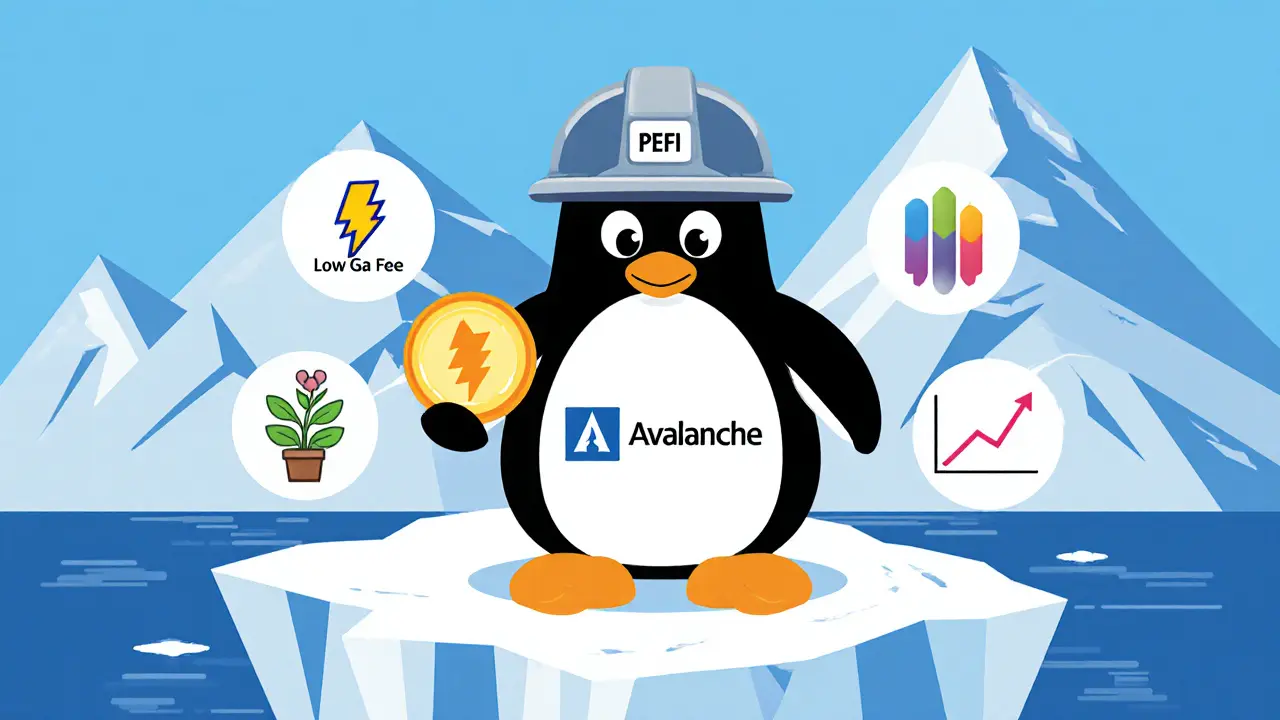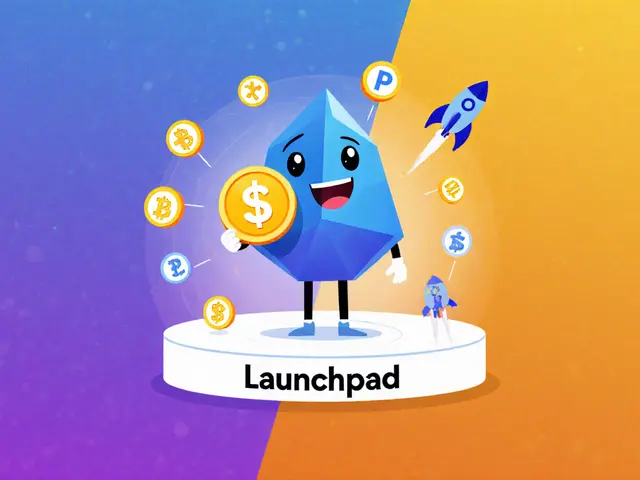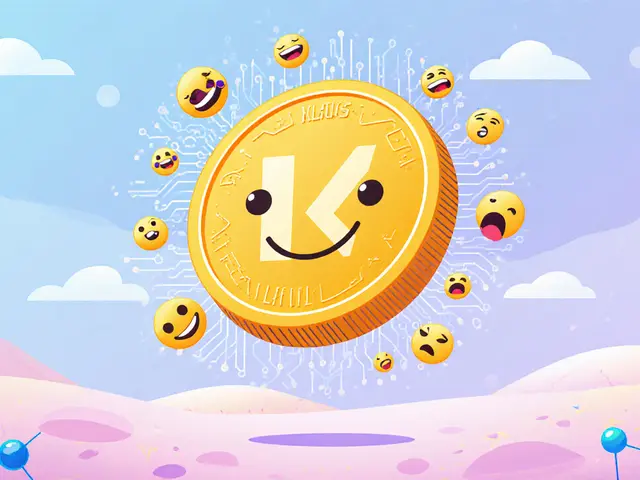KOM Airdrop by Kommunitas: Full Details, Eligibility & How to Claim
Learn everything about the KOM airdrop by Kommunitas-eligibility, claim steps, past campaigns, risks, and future plans-so you never miss a free token.
Read More

Calculate potential returns from PEFI staking or liquidity provision. Note: Current APY is very low due to low trading volume. This calculator is for illustrative purposes only based on historical data.
Penguin Finance (PEFI) is a DeFi protocol built on the Avalanche network that tries to make yield farming cheap and fast. In plain English, it’s a set of smart contracts that let you stake, farm, and trade with almost no gas fees. Below you’ll get a step‑by‑step look at how it works, why it mattered in 2021, and what its reality looks like in 2025.
Penguin Finance is a Penguin Finance is a decentralized finance (DeFi) protocol that runs on the Avalanche network, offering low‑fee yield farming, staking, and a prediction‑market game called Emperor Penguin. The project’s goal was to lower the entry barrier that high gas fees on Ethereum created for retail users.
The protocol bundles a few familiar concepts: Igloos (yield farms that accept LP tokens from the Pangolin DEX), Penguin Nests (staking pools for the native token), and an auto‑compounder that reinvests rewards without you lifting a finger.
PEFI is the utility token that fuels every action on the platform. When you provide liquidity to an Igloo, you earn PEFI as a reward. When you stake PEFI in a Penguin Nest, you receive a share of the protocol’s fee revenue (although fees have been near zero since 2023). The token also pays the small transaction fees that keep the smart contracts running.
At launch, the tokenomics were aggressive: 70% of the supply was allocated to liquidity mining, 15% to the team (locked), and the rest to community incentives. Today, about 91% of the 21 million max supply is in circulation, meaning most of the original rewards have already been distributed.
Running on Avalanche Network is a high‑throughput blockchain that finalises transactions in under one second and charges less than $0.01 per transaction on average. This speed made Penguin Finance attractive when Ethereum gas could spike above $50.
The first smart‑contract audit was performed by CertiK on 16 June 2021, flagging a moderate risk due to heavy code forking from PancakeSwap, SushiSwap, and Goose Finance. No critical vulnerabilities were found, but the report warned that extensive forking without deep customization could lead to undiscovered bugs.

The only significant market for PEFI is the Pangolin DEX, a decentralized exchange native to Avalanche. The PEFI/WAVAX pair accounts for roughly 99% of daily volume, which sits at about $33 USD. That’s a drop from the multi‑million‑dollar volumes seen in mid‑2021. No major centralized exchanges list PEFI anymore.
| Protocol | Market Cap (USD) | 24h Volume (USD) | Avg. Tx Fee | Active Users (Daily) |
|---|---|---|---|---|
| Penguin Finance | ~$120 k | ~$33 | <$0.01 | <50 |
| Trader Joe | $185 M | $12 M | ~$0.02 | ~15 k |
| Benqi | $85 M | $6 M | ~$0.03 | ~8 k |
Penguin Finance’s numbers are tiny in every column. The low fees are still a plus, but without liquidity or users the advantage disappears.
When the protocol launched, its Discord peaked at over 15 000 members and Twitter was posting multiple times a day. By late 2023 the Discord had slipped below 2 000 members and Twitter averaged barely one post per month.
The GitHub repo shows the last code commit on 17 Feb 2022. No roadmap updates have been announced since Q4 2022. Users on Reddit’s r/DeFi note that the UI often hangs, and the “Igloos” sometimes fail to process a simple stake within minutes.
If you’re hunting for ultra‑low‑fee yield farms and you have a strong belief that Avalanche will regain massive user growth, the protocol’s cheap transaction costs could become useful again. However, that would require fresh liquidity injections, new development pushes, and a community revival - none of which are on the horizon based on current signals.
Penguin Finance aims to provide cheap, fast yield‑farming services on Avalanche, letting users earn PEFI rewards with sub‑second transaction finality and near‑zero gas fees.
The primary market is the Pangolin DEX (PEFI/WAVAX pair). No major centralized exchanges list the token as of 2025.
Given the tiny market cap, near‑zero liquidity, and stagnant development, PEFI is largely speculative. It may suit traders looking for high‑risk, low‑price tokens, but it lacks fundamentals for a long‑term hold.
The CertiK audit labeled the contracts as moderate risk due to extensive code forking. No new audits have been performed since 2021, so undiscovered vulnerabilities could exist.
Compared with Trader Joe and Benqi, Penguin Finance has far lower liquidity, market cap, and daily users. Its fee advantage is similar, but the lack of depth makes it impractical for most traders.
Bottom line: Penguin Finance was an interesting experiment in ultra‑low‑fee DeFi, but today it lives in the shadow of larger Avalanche projects. If you’re curious, treat any PEFI exposure as a small, high‑risk experiment rather than a core portfolio holding.

Learn everything about the KOM airdrop by Kommunitas-eligibility, claim steps, past campaigns, risks, and future plans-so you never miss a free token.
Read More
Carlo (CARLO) is a Base‑native memecoin launched in 2024. Learn its price, tokenomics, how to buy, and the entertainment roadmap in plain terms.
Read More
Klaus (KLAUS) is an AI‑themed meme coin with a 1 billion supply, ambiguous blockchain, and very low liquidity. This article explains its basics, compares it to other AI tokens, and highlights the key risks before you consider buying.
Read More
Write a comment